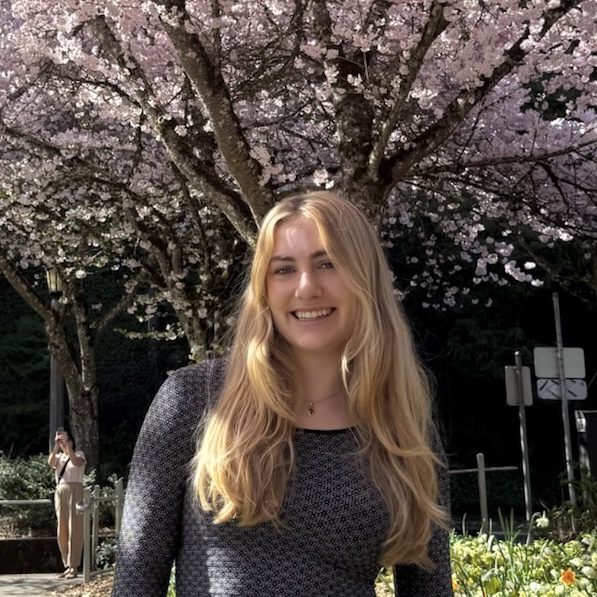Nayiri Kalindjian

Obesity is a worldwide epidemic predisposing overweight individuals to many severe illnesses, including type 2 diabetes, cardiovascular disease, and chronic kidney disease. While pharmaceutical targets like semaglutide and other GLP-1R agonists have emerged in recent years, these products have been shown to have various shortcomings and side effects, therefore raising the need for therapeutics with alternative targets. Brown and beige adipose tissue are intriguing weight-loss targets due to their thermogenic capacity — their ability to generate heat and burn fat. Previously, in our lab, we identified a novel actomyosin-mediated signaling […]
Nandika Nambiar

Colorectal cancer (CRC) remains the fourth most common cancer in the world. In my proposal, I ask the question of whether CRISPR-Cas9 methodologies can be used to selectively target and disrupt the virulence pathways of the bacterial strain Fusobacterium nucleatum, which is prevalent in our gut microbiome, to combat its pro-tumorigenic efforts in colorectal cancer. F. Nucleatum has been shown to cause colorectal cancer and promote tumorigenesis by binding to colorectal epithelial cells through the FadA adhesin protein, leading to cell proliferation and growth. This strain of bacteria and its […]
Lauren Sandberg

Reef-building corals rely on a partnership with microscopic algae called Symbiodiniaceae to form the basis of coral reefs, which provide benefits to both reef-dwelling organisms and human populations. Changing environmental conditions threaten coral reefs via coral-Symbiodiniaceae dysbiosis that can result in rapid and widespread coral mortality. While most research focuses on Symbiodiniaceae found in coral tissue, those in the environment may be key sources of Symbiodiniaceae after dysbiosis. This project explores whether sea cucumber feces, which contain material from reef sediments, may act as a source of Symbiodiniaceae with new […]
Jeshwanth Mohan

This project aims to explore the complex, multi-organ dynamics of the autonomic nervous system (ANS). While current research focuses on a single organ system, this work attempts to utilize multiple physiological signals, such as cardiac rhythms, sweat gland responses, and stomach muscle activity, to understand autonomic regulation across the body. By using a graph theoretic approach to build a dynamic network model for the ANS, we aim to develop a multivariate model that uncovers how different components of the ANS influence one another over time. This approach will reveal insights […]
Jerry Jiang

Sinorhizobium meliloti 2011 (S. meliloti) is a nitrogen fixing bacteria that enhances the growth of economically significant crops like alfalfa and fenugreek. Lanthanides are a group of metals that have great importance in modern technologies, but emerging research also indicates that they are involved in biological processes. We’ve recently discovered S. meliloti can grow on methanol, a prevalent substrate in the plant environment, only when lanthanides are added. This suggests that S. meliloti encodes genes involved in lanthanide transport and a lanthanide dependent methanol dehydrogenase. I will create mutant strains […]
Jean Choi

T cells are a key part of the adaptive immune system, responsible for recognizing and responding to specific pathogens to protect the body from infection. Immature T cells, called thymocytes, develop through a complex process in the thymus. One very important part of this process involves interactions with the thymic environment to ensure they can recognize the body’s own MHC molecules. Thymocytes that bind self peptide-MHC with moderate strength survive through positive selection, while those that bind too strongly are eliminated through negative selection to prevent autoimmunity. Chemokine receptors guide […]
Jacob Liu

In primates, spatial attention is a crucial higher-level visual process that constructs the immersiveness of our everyday experience. By better understanding the basis of attention neural networks, it paves the way for better treatments for ADHD and other attention-based disorders. However, studying the neural mechanisms behind spatial attention has traditionally been challenging due to the ethical implications of using primates as research models. Recently, mice have been highlighted as promising alternatives for modeling spatial attention. This finding inspires my project to investigate monocular spatial attention in mice and test how […]
Han Xiao

Acute Myeloid Leukemia (AML) is a blood cancer caused by the failure to produce mature blood cells, with a five-year survival rate below 30%. Understanding the molecular mechanisms of AML is essential for developing effective therapies. Recent studies show that AML cells rely on the mitochondrial electron transport chain (ETC), and ETC activity enhances overall cancer cell survival. Our lab has previously discovered several E3 ubiquitin ligases that directly sense and regulate mitochondrial import and activity. My project focuses on deciphering the specific binding sites that these ligases use to […]
Ethan Xie

Neurodegenerative diseases are notoriously difficult to treat due to their various causes and complex biological pathways. In 2014 alone, the top nine most common neurological diseases cost the U.S. an estimated 789 billion. It is hypothesized that these diseases are caused by toxic protein aggregates. As such, this project aims to investigate the mechanisms behind neurodegeneration by studying how lipid transport plays a role in the synthesis and metabolism of these aggregates by connecting with the lysosomal mTOR pathway, a master regulator of cellular growth and repair. Specifically, I plan […]
Elizabeth Wang

Cataract is the clouding of the eye lens due to protein breakdown & aggregation that often occurs when aging. It is a leading cause of blindness, and treatment includes expensive surgery that often introduces the risk of surgical complications. In the Gong lab, prior research has shown that connexin 50 knockout (Cx50KO) mice exhibit smaller lens sizes and mild cataracts. Single cell RNA-sequencing (scRNA-seq) has been performed to study the molecular mechanisms underlying lens growth inhibition and mild cataracts caused by Cx50KO. One of the differentially expressed genes (DEG) identified […]